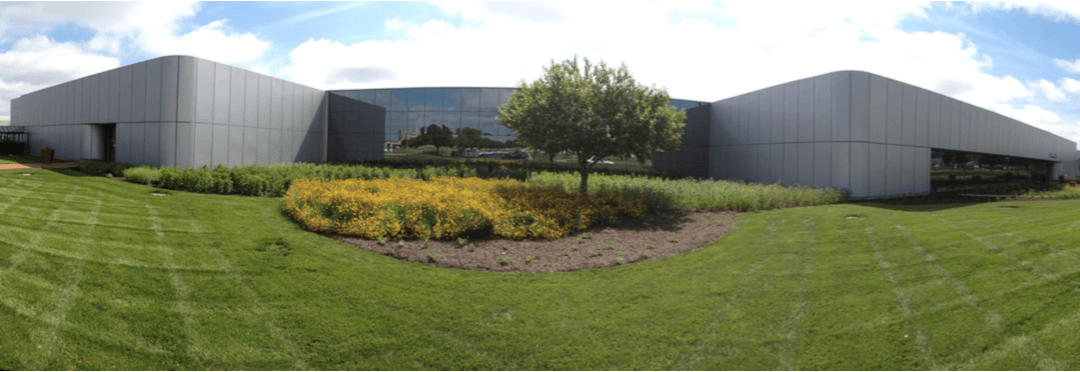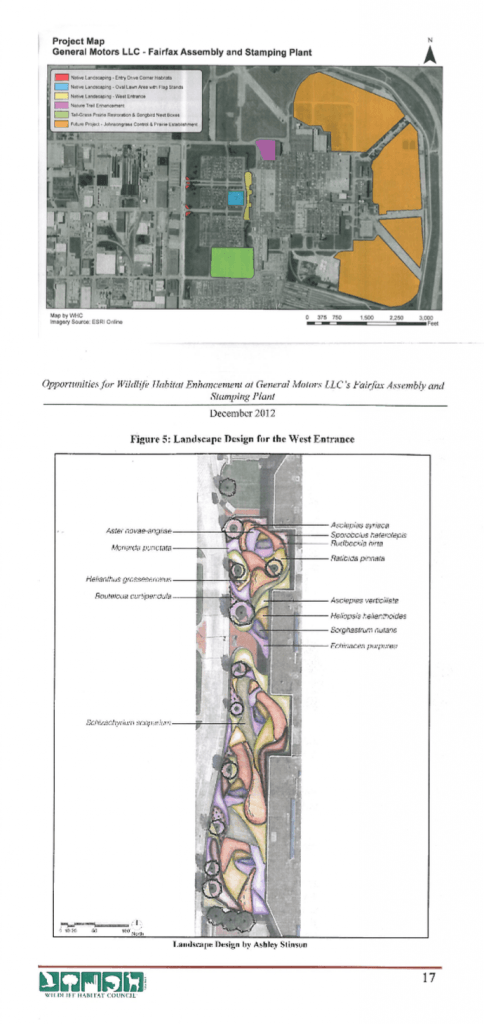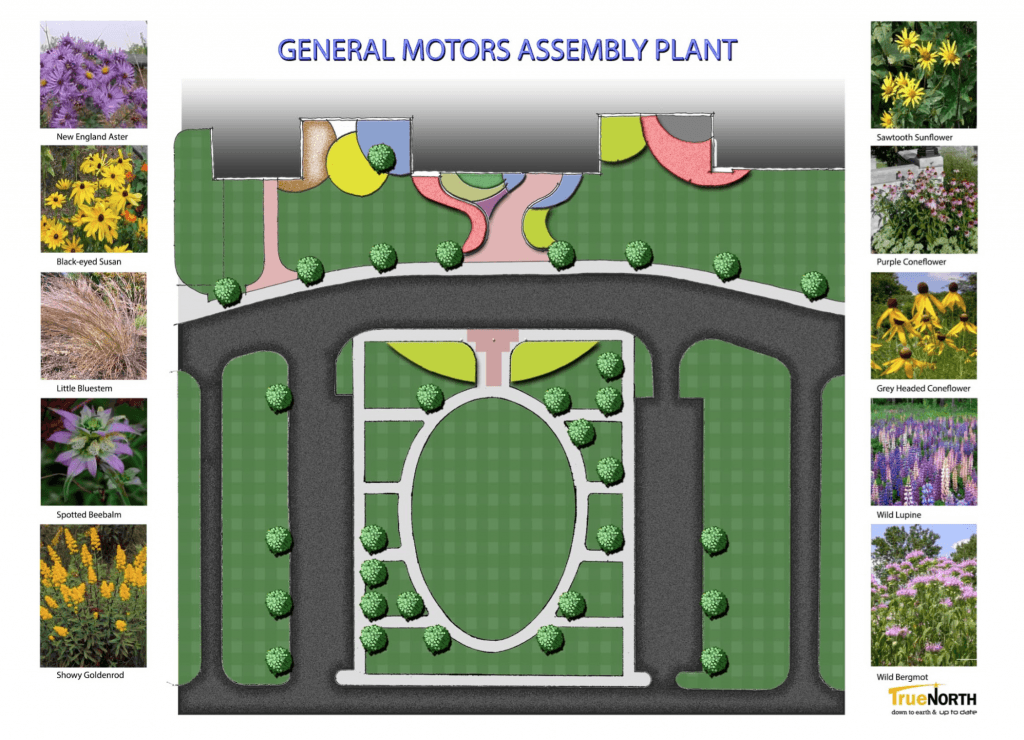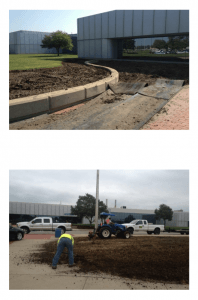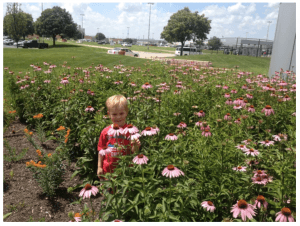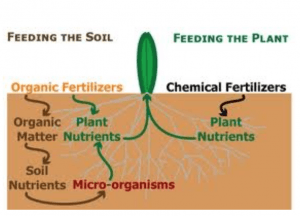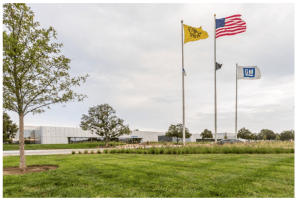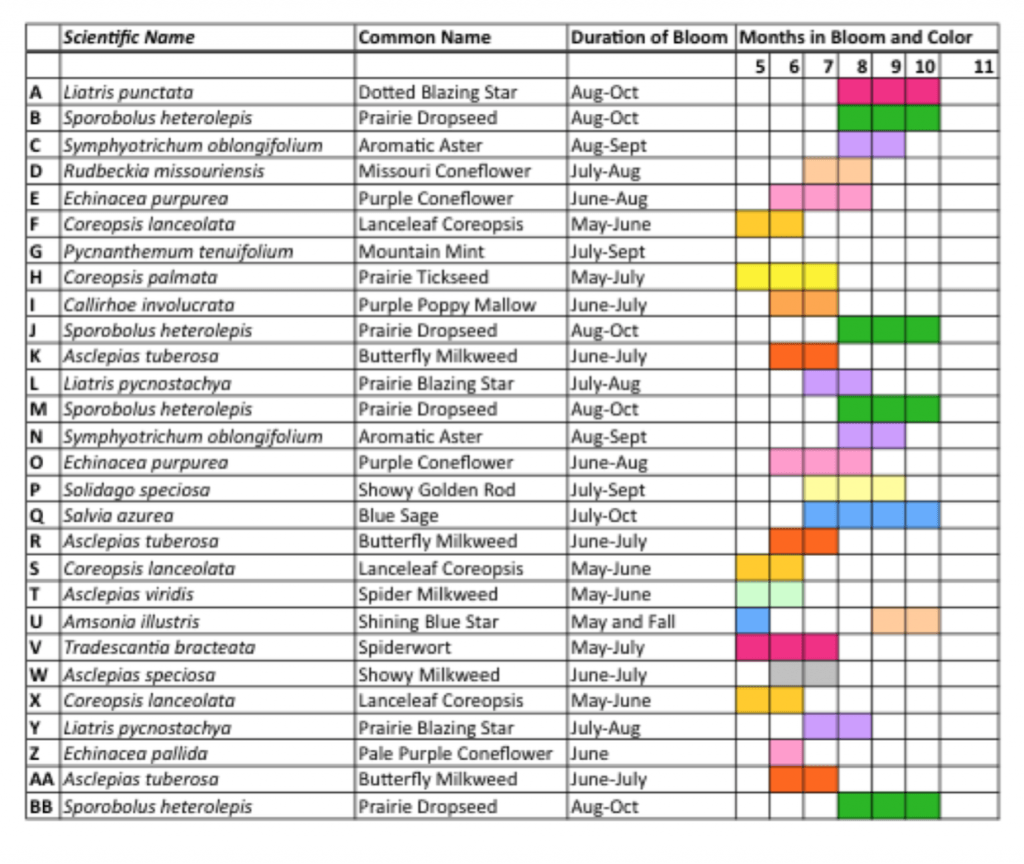Site Selection, Design, and Installation
Site Selection
General Motors first approached True North Outdoor regarding the installation of a wildlife habitat in the spring of 2013. A preliminary report, from the Wildlife Habitat Council, was provided to True North as a road map for habitat implementation. The report identified three areas where such a habitat might be successful.
The first area identified was along the front face of the assembly plant itself. This area was primarily turf with a few planting beds that contained over-mature plant material and a rock mulch.
The second area was outbound from the plant near Fairfax Trafficway and the entry drives to the plant itself. These areas were all open unirrigated turf.
The third area was at the plants jogging trail to the north behind the plant secure line. This area was un-irrigated turf as well.
After some thought and input from the Plant, the front area was selected as the first site for Habitat implementation. This area was selected in that it was at the plant front door, a perfect place to showcase a native habitat and give the plant a fresh new look simultaneously.
Design
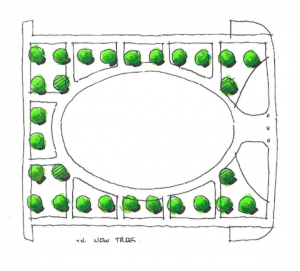
Several sketches and design ideas were drawn up to define the scope of the project. Plant selection was key to the overall concept as one of the goals was to design a habitat that could be enjoyed through all of the growing season. Elliott Duemler, a native plant expert with Applied Ecological, was consulted regarding plant selection and plant position in the beds.
Agronomist Bill Nolde was asked to take soil samples at bed locations and give recommendations for possible amendments.
In the summer of 2012, an “ET” controller was added to the irrigation system along the front of the building. This smart irrigation management system uses a local weather station to provide daily weather and rainfall data. ET water servers access the weather data, compute evapotranspiration, and generate daily watering schedules for each landscape profile. These servers then connect wirelessly back to the controller to exchange daily irrigation schedules and data. This allows the landscape areas optimal moisture while conserving water.
Installation
In July of 2013, existing plant material was removed along with several tons of rock mulch at the main visitors entry of the plant. A fresh soil mix comprised of topsoil, sand and compost was tilled in to give the new planting beds a solid base for growth. This soil was amended with an organic fertilizer to increase soil microbial population for better success.
Drip irrigation was added in all beds to help with plant establishment.
Native Plant plugs were ordered and delivered from Applied Ecological. They were planted on a triangular 18” spacing. A thin layer of mulch was applied to keep weeds at bay.
Several Pin Oaks were installed at the center pavilion area across from the front door of the plant. This space serves as a gathering space for large events.
Challenges, Successes, and Surprises
Challenges
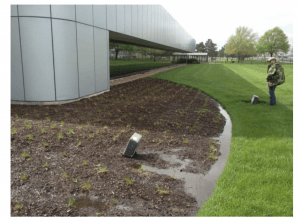 Some of the milkweeds that were used in different planting beds had a very hard time with establishment and ultimately success. Milkweed, like many other native plants native to Kansas, crave a hot dry climate to thrive. The drip irrigation along with the thin layer of mulch kept too much moisture at the surface of the soil at the base or stem of these milk weeds. This moisture, or wet condition at times, rotted the root of the milkweed. We replanted 80% of the milkweed the following spring (2014) and although the plant looked much better through establishment, is struggling.
Some of the milkweeds that were used in different planting beds had a very hard time with establishment and ultimately success. Milkweed, like many other native plants native to Kansas, crave a hot dry climate to thrive. The drip irrigation along with the thin layer of mulch kept too much moisture at the surface of the soil at the base or stem of these milk weeds. This moisture, or wet condition at times, rotted the root of the milkweed. We replanted 80% of the milkweed the following spring (2014) and although the plant looked much better through establishment, is struggling.
The drip irrigation provided a good water source for plant establishment, but also attributed to overwatering early on in the process. We quickly learned that we had to completely shut down the drip system.
Another challenge we are currently dealing with is the southern most planting bed sometimes floods after a heavy rain. As stated above, these plants don’t enjoy wet feet. As a result, the plants in this bed are smaller and seem to struggle some.
Successes
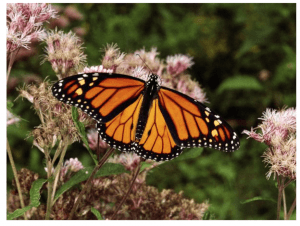 Every time we visit the habitat, we notice quite a few birds. The beds that were designed to always have something blooming, have also provided with a continual food source for them. Although, it wasn’t intentionally a goal to provide such a food source, it has worked out quite well.
Every time we visit the habitat, we notice quite a few birds. The beds that were designed to always have something blooming, have also provided with a continual food source for them. Although, it wasn’t intentionally a goal to provide such a food source, it has worked out quite well.
The bee population is on the rise. The bloom of the coreopsis, early in the summer seemed to jump start the bee population. These pollinators were busy all year.
In June of 2014, the habitat was certified as an official Monarch way-station. An iconic North American pollinator—the monarch butterfly—is in severe decline, down from a billion monarchs 20 years ago to 35 million today. Native habitat installs in urban areas, such as this one, will help curb that decline.
Research shows that native pollinators can be two to three times as effective at pollinating agricultural crops as non-native honeybees.
Surprises
The comments and appreciation of visitors to the site as well as employees has been tremendous. Mostly every time we are on site documenting the plants and the wildlife, we get a compliment or a question about the flowers. The overall success of the habitat has brought a very peaceful and fulfilling attitude to those who choose to experience these areas.
A common misconception of a native plant habitat is that these installations will appear unrefined or not manicured. This installation surprised quite a few visitors with how beautifully it developed throughout the year. The color variation and vibrancy of the blooms were a pleasant surprise to most who visited.
Environment, Culture, and Aesthetic
Environment
Chemical weed control is being eliminated or greatly reduced. As the plants have had a full growing season, the voids between plants, where weeds like to take over, are closing rapidly. Hand weeding is being utilized while this process is taking place.
The use of synthetic fertilizers has been eliminated at the native beds 100%. An organic fertilizer is used on these beds as well as all turf areas to feed the microbes in the soil, rather than the plant directly. Microbes in the soil make nutrients available for the plants. The way you feed microbes is through the addition of organic material. If you feed with a synthetic chemical fertilizer, you are feeding the plant, not the soil, or the microbes. Adding synthetic fertilizer also drives up the salt index in the soil and changes the pH, which can have adverse effects on plants.
Culture
Community Involvement is key! On earth day, several GM employees came out and helped pull weeds out of some of the beds. There were a number of questions about the different plant groups regarding blooming times and plant types. As a result, a blooming schedule was published for the plant (see below).
Bird houses were built in March by students from Douglass Elementary grades 3rd- 5th. The kids really enjoyed putting them together and getting them painted up. They were installed by the GM Environmental Group – Kevin Brown, Stephanie Kalthoff, Stephen Britton and Jeff Parker on Earth Day.
There were some questions from plant leadership regarding the health of some of the new trees as a few had lost some of their leaves earlier than expected. Bill Nolde, expert arborist, evaluated the trees and determined that some of the mulch needed peeled back from the root flare as well as some of the soil. A number of the trees had arrived from the nursery planted too deeply in the root ball. Soil was removed from the top of the root ball to let the tree get more air and dry out a bit easier after rain events.
Blooming Schedule
The Future
In September 2014, the director of the Stamping plant expressed interest in improving its break area. The first idea brought to the table was to install something similar to the habitat created at the visitors center at the front of the main plant. The thought was that employees would enjoy their break much more with something to experience through the native plants colors, smells and the wildlife they attract.
GM has added a new paint facility to the north of the existing facility. Plans are in the works to incorporate native habitat with an existing walking trail, complete with break areas and walking paths.
The breeding season of the Monarch butterfly should be successful here for seasons to come. We have provided them with a very large habitat, loaded with a number of milkweed and nectar plants needed to land their eggs. We have given them plenty of exposure to sun and shelter as well, two elements vital to the Monarch.
